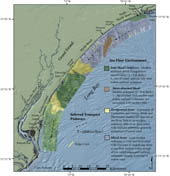|
|
Discussion
Hardground Areas

|
Figure 19. Map showing the four primary sea floor environments within Long Bay.
Click on figure for larger image and full caption.
|
Hardground areas are characterized by complex patterns of high-backscatter within the sidescan-sonar imagery, little bathymetric variation, and coarse surficial texture (figs. 4, 5 and 15). Two expansive regions of hardground lie within the study area: offshore of Surfside Beach and Pawley's Island. Little to no modern sediment is present in these areas; Cretaceous and Tertiary strata and Pleistocene channel-fill deposits are exposed at the sea floor (Baldwin and others, 2004) (figs. 2 and 3). Surficial sediment samples consisting of poorly sorted, coarse sand were collected within the hardground areas (fig. 1), suggesting that a thin layer of modern sediment may exist, but is most likely below the resolution of the geophysical systems (~ < 0.5 m). Any mobile fraction is most likely transported away from the area as deposition of fine sediment would be inhibited by near-bottom turbulence associated with the rough substrate. Baldwin and others (2004), show that the exposed strata within these areas have undergone differential erosion, probably during repeated regressive and transgressive cycles. This appears to be reflected in the complex high-backscatter patterns displayed within the sidescan-sonar imagery (fig. 12).
Studies along the Atlantic seaboard have shown that erosion of the inner shelf may provide a local source of sediment to sediment-starved regions (Pilkey and Field, 1972; Milliman and others, 1972; Pilkey and others, 1981; Hine and Snyder, 1985; Demarest and Leatherman, 1985; Schwab and others, 1997, 2000; Thieler and others, 1995, 2001). Riggs and others (1996) have shown that degradation of relict strata in neighboring Onslow Bay (fig. 1) provides a local source of sediment to the coastal system. Ojeda and others (2004) and Gayes and others (2003) suggest that hardground areas within Long Bay may also contribute sediment to the coastal system through active erosion by biological and mechanical processes. However, the coarse-grained nature of the sediments within the hardground areas implies that erosion may primarily occur during storm events, when conditions for entrainment and transport of coarse material would prevail (Gayes, 1991).
|